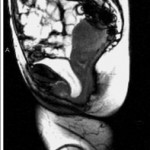A group of disorders that involve hernias of the female pelvic organs is termed as a prolapse. Pelvic organ prolapse is a common problem witnessed in older women who have experienced vaginal deliveries or urinary tract infections that cause pelvic floor muscles to weaken. These muscles can therefore not support any pelvic organs, causing their prolapse.
If left untreated, this condition can disrupt day-to-day lives of women. Unfortunately, this condition often goes undiagnosed during a routine static MRI. A dynamic MRI, however, picks up this condition as women bear down or perform a straining manoeuvre.
In a study performed at NYU Langone Medical Centre in New York, 84 women aged 18-81 years, with suspected urethral diverticulum, underwent dynamic and static MRI scans, of which ten were found to have an abnormality of the urethra. In these patients, prolapse was found in static “at-rest” images in about 12 percent, while it was identified in 87.9 percent only in dynamic “straining” sequences. “33 patients were diagnosed with pelvic organ prolapse, of whom 29 were diagnosed exclusively on dynamic imaging,” said Genevieve L. Bennett, M.D., assistant professor of radiology at NYU Langone Medical Centre and lead author of the study. This study was published in the American Journal of Roentgenology.
urethral diverticulum, underwent dynamic and static MRI scans, of which ten were found to have an abnormality of the urethra. In these patients, prolapse was found in static “at-rest” images in about 12 percent, while it was identified in 87.9 percent only in dynamic “straining” sequences. “33 patients were diagnosed with pelvic organ prolapse, of whom 29 were diagnosed exclusively on dynamic imaging,” said Genevieve L. Bennett, M.D., assistant professor of radiology at NYU Langone Medical Centre and lead author of the study. This study was published in the American Journal of Roentgenology.
“The results of this study show that in women with lower urinary tract symptoms who undergo MRI for evaluation of a suspected urethral abnormality, the addition of dynamic MRI permits detection of pelvic organ prolapse that may not be evident on static at-rest images and that may also go undetected at physical examination,” the authors write.
Article by Snigdha Taduri for Biomed- Middle East

I am trying to locate stats on types and frequency of pelvic organ prolapse throughout the world; if you have access to any of this information for the middle east area, I’d truly appreciate anything you’d be willing to share.
Sherrie Palm
Pelvic Organ Prolapse: The Silent Epidemic